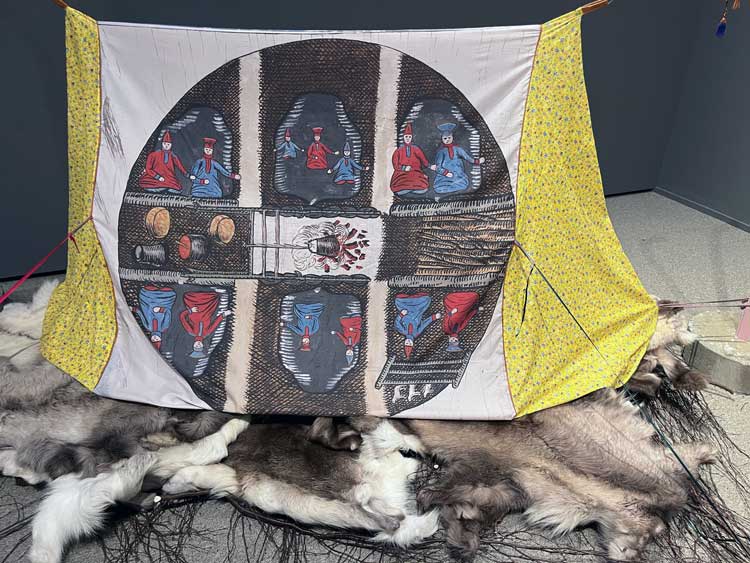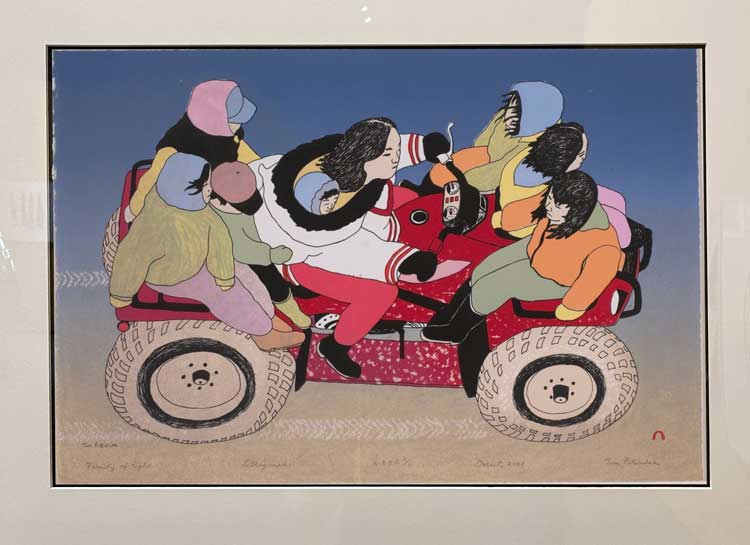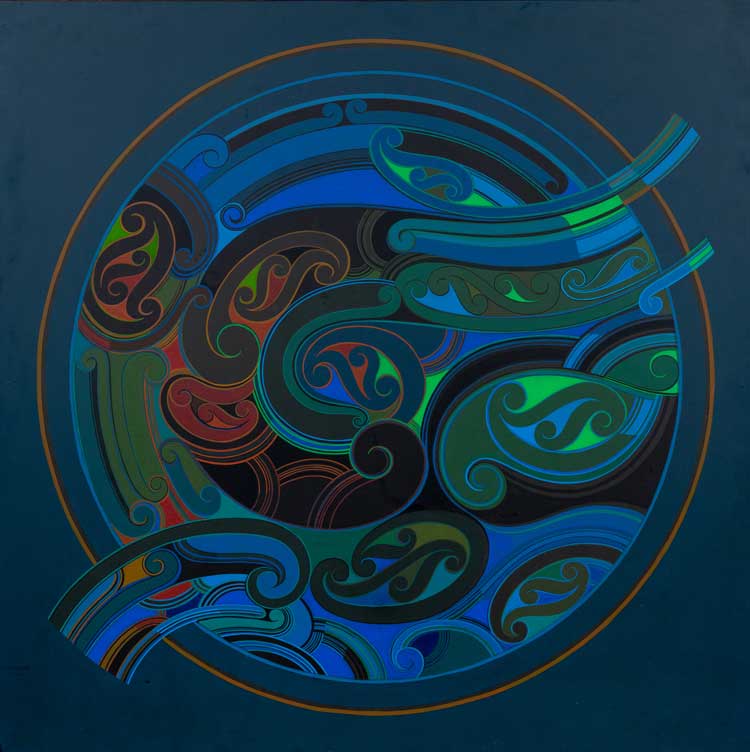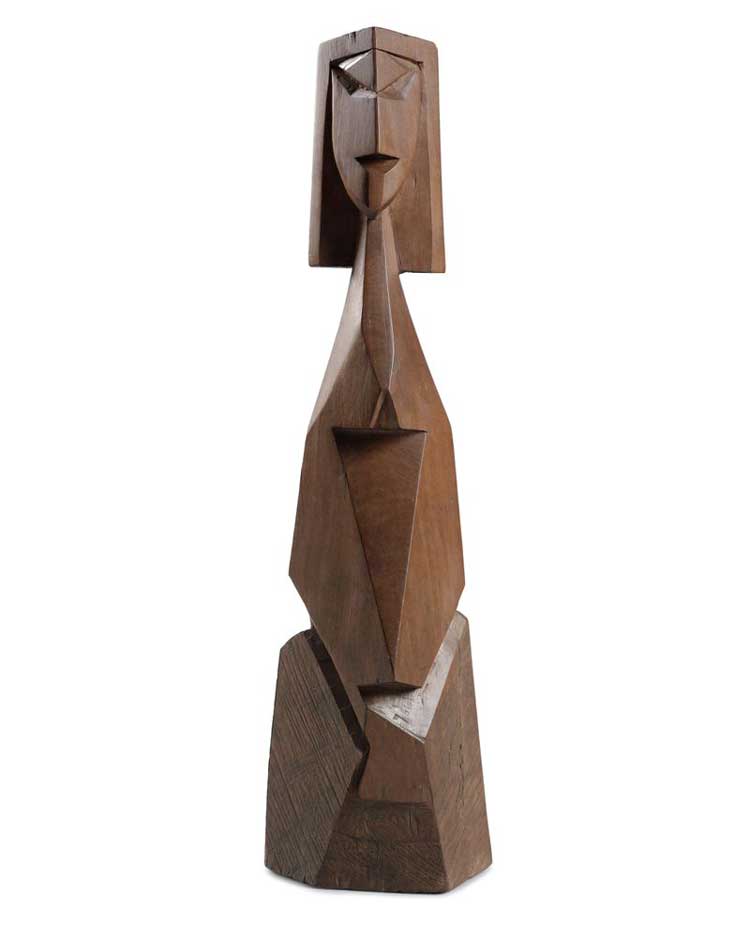-1000.jpg)
Máret Ánne Sara, Oaivemozit / galskap / madness, 2013. Sámi Art Collection. © Máret Ánne Sara.
Kode Bergen Art Museum, Norway
26 April – 25 August 2024
by VERONICA SIMPSON
“Why is this exhibition of interest to the international press?” a young reporter from a Bergen newspaper asked me as I stood staring at a painting in the Kode art museum. His slightly hostile tone surprised me. We were at the press opening of Indigenous Histories, the first exhibition in Bergen dedicated exclusively to indigenous art from different regions and the largest of its kind in Norway. What’s not to celebrate? I told him my interest was initially sparked because this is a beloved project of Adriano Pedrosa, artistic director of the Venice Art Biennale 2024 and director of the Museu de Arte de São Paulo Assis Chateaubriand (MASP), where he launched the show in 2023. I felt it could provide valuable insights into his thinking about who gets included in the global art narrative. The reporter persisted: “But we were told we should come here to see this show because the international press is here.” I replied: “Actually, I would imagine this show is important because it shows Sámi art from the indigenous Scandinavian communities, and it places them in context with many other kinds of indigenous artists. And because it is suggesting there is much to learn from all these artists, and their art deserves its place in the contemporary scene alongside all kinds of other art.”
He scribbled a couple of sentences in his notebook, thanked me and left the gallery. Whether my thoughts were accurately represented I have no idea. “It’s a very Norwegian thing,” a friendlier local arts journalist told me, having overheard. “We don’t appreciate things in our culture until other people show an interest in them.”
Well, there is much to interest Norwegians as well as non-Norwegians in this show. It features 285 works from more than 170 artists from Brazil, Canada, Mexico, Sápmi, New Zealand and Australia, billed as art that will “transcend borders and stimulate the new through a variety of media typologies, origins and periods”. The works date from 200BC to 2024, and the “histories” in the title is used in the Portuguese as well as the Norwegian sense, as “encompassing both fiction and nonfiction, historical accounts as well as personal ones, of a public and private nature, [at] a micro or macro level”. In this, the curators – and there is a large team of them, specialists in each region – hope to present: “a more polyphonic, speculative, open, incomplete, preliminary and fragmented character”.
The work is arranged in seven regionally distinct spaces, along with a gallery dedicated to “activist” art.
-installation-view-V-Simpson.jpg)
Outi Pieski. Dominant is Crossing Paths, 2014. Installation view, Indigenous Histories, Kode Bergen Art Gallery, Norway, 2024. Photo: Veronica Simpson.
It could be daunting, but luckily, the first room has real impact. It is dedicated to Sámi artists and we are warmly invited into their culture and landscape, thanks to the scale and variety of the work. Dominant is Crossing Paths (2014), Outi Pieski’s hanging sculpture made of hand-knotted textile tassels – an earlier version of the shimmering structures that until recently occupied Tate St Ives (see Studio International’s interview with Pieski), conjuring a sense of immersive experience – depicting the colours of a landscape (a wintry monochrome in this case) as well as the feeling of being in the landscape.

Katarina Spik Skum and Joar Nango. Rákkas III, 2020. Installation view, Indigenous Histories, Kode Bergen Art Gallery, Norway, 2024. Photo: Veronica Simpson.
Beyond that, there is the soft cloth of a tented structure, Rákkas III, 2020. A collaboration between Katarina Spik Skum and Joar Nango, it is inspired by the traditional Rakkas, a small tent that sits within the traditional Sámi dwelling and offers a space of retreat from the rest of the household - including somewhere for procreation. Motifs printed on the fabric are illustrations of Sámi architecture taken from the accounts of the Norwegian priest and linguist Knud Leem (1697-1774), in a 1767 book about the Sámi, and are used here to flag up the power that lies in the images and perceptions with which colonising cultures appropriate and disseminate ideas about the colonised.
A tipi printed on to this Rakkas echoes the form and pinnacle of a kind of tipi constructed by Lena Stenberg out of wooden stools, chair legs, spades, drawers and assorted items of furniture, to evoke the economical way in which nomadic Sámi communities move through the landscape and the durability and craftsmanship of the objects they take with them. It challenges us with its hand-carved, smooth, inviting, yet impenetrable structure.

Marja Helander, Hidden from the Day, 2018. © Marja Helander / BONO.
Placing us firmly within the troubled political undercurrents of the Sápmi landscape (the Sápmi territory includes northernmost Finland, the northern parts of Norway and Sweden, and Russia’s Kola Peninsula) are two photographs by Marja Helander, from her series North (2018), highlighting the threats to traditional lifestyles in Sámi areas from mining, wind power plants and green colonisation. In one, Hidden (2018), a feathered creature, part-human and part-bird, is standing on a cliff above Giron on the Swedish side of Sápmi, waving its arms as if in warning. The town is currently being dismantled and relocated due to the dangers of extensive mining. The vulnerability, the soft folds and contours of this mature woman’s naked body as she stands with her back to the camera, and the twilight setting, makes us all too conscious of what is at stake, as the lights of the mining town – mid-demolition - glow in the distance. In the companion photo, Hidden from the Day (2018), a woman crouching in a field is almost covered by feathers which also fly around her, lit by the setting sun. The image is half euphoric, half menacing.
To the rear of the gallery, a large painting of graphic shapes in luminous colours, The Sun Sign (2007) by Alf Salo, replicates the after-effects on the retina from staring into the new spring sun after months of darkness. Nearby is Gjert Rognli’s What Nature Knows II, a photograph of a natural pothole filled with a glowing, red liquid, implying a subterranean passage, a portal to the spiritual world or a fleshy component hidden within the folds of rock.

Gjert Rognli. What Nature Knows II. Installation view, Indigenous Histories, Kode Bergen Art Gallery, Norway, 2024. Photo: Veronica Simpson.
There is an additional room adjacent to this one, with moody, glacial-blue walls. A few ancient craft objects – two knives, a necklace, an amulet – are displayed, taken from a historic museum collection. Next to this is a sculpture by Iver Jäks, a long-established Sámi artist who brings a contemporary artistic twist to traditional craft objects, known as duodji. This one is apparently reminiscent of a sacred rock, with sacrificial gifts placed around its base and crowned with reindeer antler. A traditional Sámi lasso dangles over it.
On the wall beside it, two examples of the glowing embroidered work of Britta Marakatt-Labba, who has a major show now at the National Museum in Oslo.
Hanging sculptures made from the stomachs of slaughtered reindeer hover near the entrance, from Máret Ánne Sara’s series Gutted (2022), which was shown in the striking installation at the Nordic Pavilion of the Venice Art Biennale 2022. In Sámi culture, every part of an animal has a purpose and reindeer stomachs are used to store, preserve and dry blood or milk, but also serve as pots for cooking meat during reindeer migration season. Thus, the curators and artists here set the tone for the show really well: to evoke a vivid sense of place, people and traditions as well as skilled transformation through individual artist practice.
We meet some of Canada’s indigenous artists in the next, larger room, which presents as a wide, open space, with all the, mostly two-dimensional work, lining the walls. But the colour, warmth and variety of these works is particularly engaging, as are the subjects, evoking family, community, kin and connection. That includes The Visit (1987), a painting by Jim Logan that lays out a scene of what the wall caption tells us some scholars of indigenous art call “’deep visiting’…a gathering that takes place within the intimate geographies of the community – in family homes, bingo halls, living rooms, on the land, and around kitchen tables, where hearts and bellies are filled. Logan shows us an interior that is multigenerational and “a place of daily life”.

Tim Pitsiulak. Family of Eight, 2008. Lithograph on wove paper, 38 x 56.3 cm. Installation view, Indigenous Histories, Kode Bergen Art Gallery, Norway, 2024. Photo: Veronica Simpson.
Tim Pitsiulak’s lithograph Family of Eight (2008) shows a mother and her seven children seated happily in an all-terrain vehicle. Much of the room is given over to cosmological and symbolic work, such as Jerry A Evans’ Caribou Migrations (2007). It shows, from an overhead perspective, a herd of caribou flowing towards a cosmic circle at the centre, a “wheel of life’, with antlers forming a decorative border. There’s also a skilful weaving of environmental and protest narratives into some of the works at the far end of the room, using indigenous symbols, such as Susan Point’s Circle of Life (2007), which at first looks like a pleasing, impenetrable graphic but turns into salmon fish heads swimming inwards from four directions, their body and eye contours creating a watery ripple effect.
Often the simpler works are the most effective: for example, Melissa General’s photograph of a woman walking away from us through a forest trailing her long red shawl behind her (Nitéwake: non [The Place Where I Come From] 2015); or Tania Willard’s woodcut of a child blowing the seeds off a dandelion head, across a line of armed and helmeted guards (I Only Learned Freedom, 2019). Heather Campbell’s Nuliajuk in Mourning (2017) looks at first like an attractive watercolour of a whale with her infant, but when you look closer you see that plastic detritus fills their stomachs and spews all around them, and you can also make out the head of a woman hovering over the mother whale’s head – the face of Nuliajuk, the Inuit sea goddess, in a state of shock and grief.
Moving into the next gallery, featuring New Zealand, everything feels a bit flatter. As with Canada’s room, most of the works are two-dimensional, hanging on the walls, but quite a lot feature graphic shapes, motifs and illustrations, which don’t hold the attention in the same way. Set behind glass are two imposing, carved wooden figures by Arnold Manaaki Wilson, from about 1965, which have more of the flavour of classical “primitive” art, but with the artist conjuring a powerfully forbidding impression from the faces and forms of these figures, both squat and tall. Some works rely on superficial, surface decoration such as the cute, manga-style illustrations from Jessica Hinerangi, or the photoshopped images by Māhia Te Kore, of divas with flaming fingernails and heart-emoji hands, which feel like tattoo-parlour art.

Sandy Adsett. Koiri Series, 1981. Acrylic on board. Collection Sandy Adsett, and Ngāti Pāhauwera, Hastings, New Zealand. © Sandy Adsett.
Focusing on contemporary Aotearoa New Zealand artists, the room caption says the work “examines and unpacks” some of the forms of representation that have impacted and shaped conversations about Māori art. But the more obviously contemporary work struggled to justify its place in the room, while greater flair and originality was found in work representing traditional techniques and forms, such as Arnold Manaaki Wilson’s sculptures, or Sandy Adsett’s acrylic motif on board, from his 1981 Koiri Series. The work of Adsett, a champion of Māori traditional art through the 60s and 70s, takes something you might expect and renders it beautiful and unusual. It deploys the whorls and swirls of Māori art in a choreography of intense colour and line, achieving a spatial and emotional complexity; it seems to speak of things external and elemental (of river flows and nature) and internal, almost cellular.

Arnold Monaaki Wilson, Mihaia te Tuatahi (The First Messiah), 1965. Puriri timber. Te Papa Tongarewa, purchase, 1999, with New Zealand Lottery Grants Board funds, Wellington. © Arnold Monaaki Wilson.
We are back with a bang in Peru: an impactful presentation filled with three-dimensional works and walls richly ornamented with paintings, photos and textiles, as well as a line of upside-down antique indigenous masks along the top of each wall. The motif in this room is: “Pachakuti – the world turned upside down”. A caption tells us: “Pachakuti is a Quechua and Aymara concept that refers to a radical change in the order of space and time. This radical change is what has transformed the world of many civilisations upon coexistence with the Europeans.”

Antonio Paucar, Pedro Gonzáles Paucar and Javier Gonzáles Paucar, Homage to the Martyrs of the Battle of Azapampa 1820, 2021. Installation view, Indigenous Histories, Kode Bergen Art Gallery, Norway, 2024. Photo: Veronica Simpson.
In the foreground is a large floor work framing a red-dust landscape strewn with cacti and scattered with small, painted, wooden representations of people clearly felled in a terrible battle. From Antonio Paucar, Pedro Gonzáles Paucar and Javier Gonzáles Paucar, this is Homage to the Martyrs of the Battle of Azapampa 1820 (2021). It shows the end of one of the most important battles fought for the independence of Peru, which, because it was led by Andeans, has been written out of the history books. Through their research, the artists have attempted to identify and represent all the individuals who took part. As a result, this work emphasises that resistance is a collective and individual effort.
Many of the portraits are literally turned upside down. Luckily that’s not the case with ç. In this unusual self-portrait – which represents woman as creator, interacting with nature – you can’t see the artist’s face, but you do see her back, the back of her head and the back of her hand as she paints.
Some works defiantly present the indigenous people in formats from which they were traditionally excluded: such as an oil portrait by José Sabogal, one of the founders of Peruvian art, who studied European classical techniques at Lima School of Art in the 1920s, but used his skills to showcase Peruvian natives, such as the woman shown here in La Santusa (1928), proud in her plaits and woven robes. Some celebrate traditions, such as a huge, joyful and colourful painting by Patricia Rengifo, Big Party (2023), which depicts Ani Xeati, a traditional festival. Others, with pop-art and graphic power, depict colonising practices, such as Susana Torres’ sculptural presentation of a large sack of wheat flour (Fordo Inka; Inka Bundle, from a 2011 series), which flags up that this grain, which involves far more extractive farming techniques, has replaced the native Andean staple, corn, in the national diet.
The interrogation and representation of women’s roles features strongly, both in Peru and Brazil, where a hilarious video work, O Parto (2021) by Olinda Yawar, shows the face of a woman who is clearly giving birth, but periodically drawing up into the frame with her not a baby but a bunch of bananas and other assorted fruit, to demonstrate all the other forms of labour into which women are drafted. I also liked a huge painting by Duhigó, called Nepũ Arquepũ (2019), Monkey Hammock. It shows a spacious and well-built hut in which mother and baby are traditionally allowed to rest and recover after birth.
-Pic-V-Simpson.jpg)
Frida Kahlo. There Hangs My Dress, 1933. Collage, oil, masonite, 46 x 55 cm. Installation view, Indigenous Histories, Kode Bergen Art Gallery, Norway, 2024. Photo: Veronica Simpson.
With Mexico, we enter another realm of rich, sculptural and textural elements. Especially striking is a kite structure, largely composed of glittering emergency blanket material, by Federico Cuatlacuatl. He is still finishing its construction as the exhibition readies itself for opening. Cuatlacuatl talks eloquently about being an undocumented migrant, who was smuggled to the US as a child, and how this kite is about smuggling things or people. Its frame is composed of elements taken from the kind of “ticky torch” that was carried on to the campus of the University of Virginia in Charlottesville, where he now teaches digital arts, on the day he started work, by a group of protesting neo-Nazis. The incident made world news. “The emergency blanket material speaks of survival, and urgency and emergency,” he says.
Elsewhere in this room there is eloquent still life and portrait photography by Maruch Sántiz Gómez; minimalist tapestries by Alberto Ruiz; textile art by María Sosa; graffiti; many potent graphic works and paintings; a mesmerising work of almost black chain-stitch embroidery by Ana Hernández, and even a welcome appearance from Mexico’s art legend Frida Kahlo, with an unusual collage painting representing the strange collision of worlds and landscapes and objects of an artist straddling the old and new worlds of the US and Mexico.
Referring to an earlier comment by my Norwegian colleague of not appreciating the work of your native people until others show an interest, we come to Australia, where the work of Indigenous artists has been on the map for at least four decades. Rather than try to represent it in its entirety, the curator Bruce Johnson-McLean has picked a particular moment, in 1971, when a group of Aboriginal men in the Western Desert state participated in a local school art project, and discovered a way of translating cultural laws, stories and world views into the dot paintings for which the nation is now famous – though Johnson-McLean tells us it was only after these paintings were embraced by the world at large that the Aussies themselves took an interest. There are several works by this group of men here, but also works that evolved from the women of this community and beyond. Johnson-McLean says: “It was seen as the men’s movement to begin with, and women are not acknowledged until the early 90s, when a group of significant female leaders from Desert state painting pushed the door open.”
The men’s work, he says, is about “the sense of place, the genesis story. The stories that women generally tell relate more to existence and survival - the things that have sustained people for tens of thousands of years. The way that is communicated is through song (by women). It’s said that the paintings are sung into existence.”
-Pic-V-Simpson.jpg)
Yukultji Napangati. Untitled, 2006. Installation view, Indigenous Histories, Kode Bergen Art Gallery, Norway, 2024. Photo: Veronica Simpson.
He talks of the “lyricism in the paintings, abstracted through song”, and he is right. I could stare for hours at Yukultji Napangati’s golden, pulsating lines, said to represent heat haze in the desert, Untitled (2006), or Bush Plum Dreaming (2002) by Angelina Ngal Pwerle. To conclude such a packed and varied show with this end room, its walls lined with these dense and meditative works, is a joy – and I am grateful for the comfy seats provided for that meditation.
It is an extraordinary show, and I am glad to have seen it. I wholeheartedly agree with Pedrosa’s statement in the sumptuously illustrated catalogue: “We believe that the art of native peoples, in essence and in its diversity, generates both material and immaterial wealth that can be difficult for non-Indigenous people to understand. Indigenous artists bring ancestral cosmopolitics to life; their work is not merely ‘contemporary art’ – a term often utilised only to capture the attention of the public. Indigenous art offers tools of existence and survival that do not allow the sky to fall down, and in which all the worlds have no end, but are all acting in the defence of all life that exists. It is necessary to think beyond the vocabulary and logic of western institutions. Art is also an enchantment that works to keep [as the Brazilian writer Ailton Krenak puts it] ‘the bed of reserved dreams’ alive in a commitment to the next generations.”